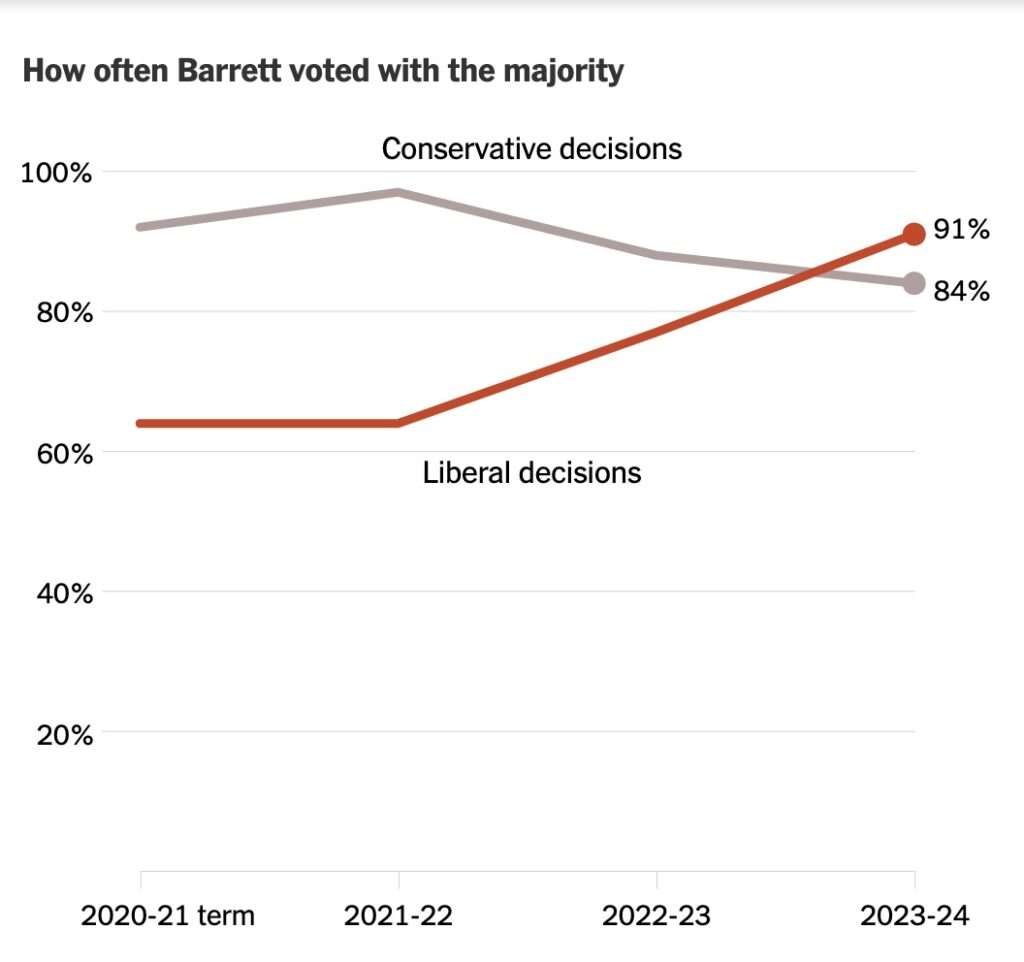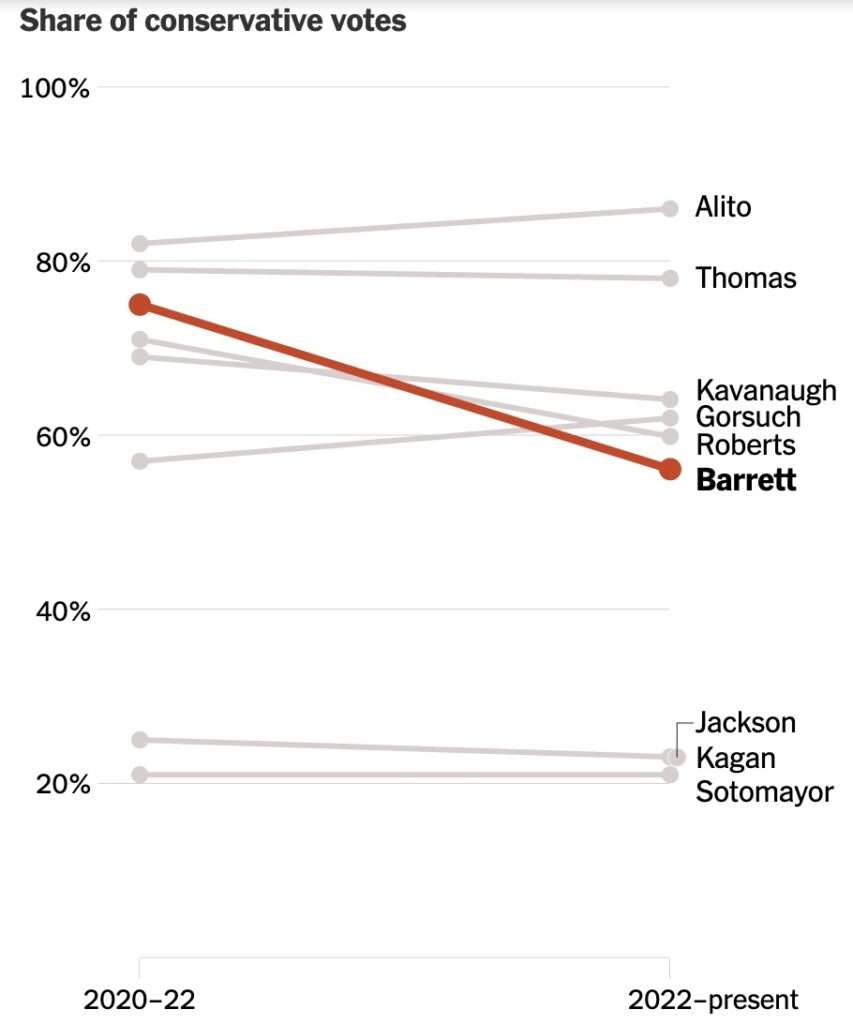Jodi Kantor published a detailed expose about Justice Barrett. Very little here surprises me. I’ve laid out the case many times. Based on Barrett’s record, she should have never been nominated for the Seventh Circuit, she should have never been put on the Supreme Court “short list” before she decided a case, she should have never been a finalist for Justice Kennedy’s seat barely a year into her tenure on the Seventh Circuit, and she should have never been elevated to Justice Ginsburg’s seat with so much unknown about her. Yet, all the while, people who held important positions in the conservative legal movement assured us that Barrett was “solid.” They could point to nothing tangible to make this case, other than their personal connections with Barrett, her academic credentials, and her Scalia clerkship. In the end, Kantor writes, President Trump picked the candidate he thought would help him get re-elected.
As President Trump was leaning toward appointing Amy Coney Barrett to the Supreme Court five years ago, some advisers shared doubts about whether she was conservative enough. But he waved them away, according to someone familiar with the discussions. He wanted a nominee religious conservatives would applaud, and with an election approaching, he was up against the clock.
Justice Barrett is who she is. I think it is a mistake to say she is “drifting,” since she really didn’t have a starting place for jurisprudence. She is figuring things out as she goes along. So it is hard to blame Justice Barrett for doing what was entirely predictable. Indeed, I think Barrett is doing exactly what an untested and inexperienced law professor would do if elevated to the Supreme Court. Truly, I don’t blame her. People misunderstand my criticism of Justice Barrett.
Other than some members of the Scalia clerk family, Barrett’s biggest defenders are in the academy. It’s hard to blame law professors–especially those who were friends with Barrett before she was nominated. Moreover, when law professors defend Justice Barrett, they are not merely defending ACB. They are defending their own guild–the notion that a law professor can be the ideal type of judge.
Finally, the blame should not lie with President Trump. He made the best decision he could based on the names put before him. It’s not the President’s job to vet the pool of Supreme Court nominees. I think he is already experiencing buyer’s remorse.
So who bears the blame? The blame should lie with those who pushed Barrett forward at every stage of the process. Despite everything we learned from the Roberts and Souter nominations, people just wanted to believe Barrett would be something she is not. And we will pay the price for that hubris for decades to come.
Kantor quotes Barrett who drew an analogy between the Constitution and Odysseus.
In classroom lectures, she used to say that the country had bound itself to the Constitution the way Odysseus had tied himself to the mast of his ship, to resist whatever political sirens swam up.
To continue the mythological theme, I feel like Cassandra. I predict what will happen, but no one will listen to me. Maybe that will change.
Let’s walk through the details from the Times.
First, Kantor offers some new insights about PennEast Pipeline v. New Jersey.
Soon after Justice Barrett arrived at the court she began surprising her colleagues. Chief Justice John G. Roberts Jr. assigned her to write a majority opinion — among her first — allowing the seizure of state property in a pipeline case, according to several people aware of the process. But she then changed her mind and took the opposite stance, a bold move that risked irritating the chief justice.
This case split 5-4. Chief Justice Roberts wrote the majority opinion, which was joined by Justices Breyer, Alito, Sotomayor, and Kavanaugh. Justice Gorsuch wrote one dissent, which was joined by Justice Thomas. Justice Barrett wrote a second dissent, which was joined by Justices Thomas, Kagan, and Gorsuch.
Jon Adler writes that Barrett “did not lose the majority so much as she abandoned it by changing her position.” That is right. It is also possible that Justice Kagan tagged along with Barrett, turning a 7-2 decision into a 5-4. I’ve long suspected Roberts tries to keep 5-4s down to a minimum, but these sorts of heterodox splits are hard to complain about. At the time, I noted Kagan’s joining of Barrett:
More often than not, Justice Kagan has to suppress those urges to keep a majority opinion. But during oral arguments, and when she is in dissent, Kagan shows her scholarly flair.
I didn’t appreciate at the time how Kagan was trying to cozy up with Barrett. PennEast may have been one of the early datapoints. And the double-flip would have really irritated the Chief Justice, since he probably saw EK’s game.
I wrote two posts about PennEast back in June 2021. For those who care about the flashback, I praised Barrett’s dissent. I wrote:
I’m glad to see that Justice Barrett is flexing her intellectual muscles. Her Penn East dissent was the strongest opinion she has written so far.
I’ve often thought about PennEast. It showed so much potential. But I haven’t seen anything from Barrett in this ballpark in recent years. Instead, we just see this caution and hesitancy.
Second, Kantor elaborates on her previously reporting concerning Dobbs: namely, Barrett did not want to grant cert.
That term, he was pushing to hear Dobbs v. Jackson Women’s Health Organization, the case that would eventually overturn the federal right to abortion. Justice Barrett initially voted with him, but voiced concerns about taking on such a big issue so soon after her arrival at the court, then switched to a no, according to two people familiar with the process. Justice Alito and three other male justices, the minimum to accept a case, greenlighted it and bet correctly that she would vote with them on the ultimate decision, upending a right that had stood for a half-century.
Surely Barrett couldn’t think that the abortion issue would benefit from percolation (like in Snope). And Dobbs didn’t arrive on the emergency docket. There was absolutely nothing for a procedural originalist (or is it an original proceduralist) to object to. The only reason Barrett would not vote to grant cert in Dobbs was that she was either (a) worried she might affirm or (b) worried about the optics of overruling Roe so quickly. Kantor supports the latter, but I’m not sure certain. I am still dubious about Judge Thomas saying he hadn’t thought about Roe since law school. Had Professor Barrett–a Scalia clerk!–really never thought through about whether she would vote to overrule Roe? And did she not have an answer in mind when she was first confirmed?
But once cert was granted, Barrett promptly joined the majority opinion. There was no half measure, or way to prolong the Roe status quo.
Third, I remained convinced that if the Court had punted on Dobbs, ACB circa 2025 or later would not vote to overrule Roe. Indeed, I think the 2022 term transformed her. That will likely be seen as an inflection point. And Kantor supports that observation:
After Justice Barrett’s second term, her agreement on outcomes with Justice Alito slid from 80 percent to 62 percent, according to the analysis prepared for The Times, by Lee Epstein and Andrew D. Martin, both of Washington University in St. Louis, and Michael J. Nelson, of Penn State. At the same time, Justice Barrett was forging bonds with Justices Sotomayor and Kagan. For them, nearly all roads to victory run through the justice from South Bend, Ind.


I am grateful that Justice Alito carried the Dobbs ball across the goal line in that landmark term. And kudos to Justice Kavanaugh for providing the fourth vote for certiorari.
Fourth, the article says in several places that Professor Barrett was not interested in becoming a federal judge:
When others tried to draft her for the bench, she was uncertain about becoming a judge, according to those who know her well. . . .
Though others envisioned her on the bench, she was not sold. By 2017, when a seat opened up on the U.S. Court of Appeals for the Seventh Circuit, covering three Midwestern states, she had a stack of teaching awards and a brimming family life, including a young child with Down syndrome. William Kelley, a Notre Dame colleague with Washington connections, encouraged her but figured she would not pursue it, he said.
“Attention, power, cool things, elitism — she has zero interest,” he said of his friend, who once served on the university’s parking committee.
I’ve often said that a person who wants to become a judge should have no business becoming a judge. I suppose the opposite is also true: a person who doesn’t want to become a judge has no business becoming a judge. The careful reader may observe a contradiction here. So be it. But I think both statements are true. People who are hell-bent on becoming a judge will say or do anything to appease the right people who can elevate them. On the plus side, wannabe-judges will have been seasoned in swamp culture and can navigate political morasses. On the down-side, wanna-be judges have been seasoned in swamp culture and can navigate political morasses.
In much the same way, Barrett was the worst conceivable candidate precisely because she had never been tested in any meaningful way. Being a smart academic is not preparation for being a federal judge. And don’t even try to compare ACB to Scalia, Bork, Breyer, or Ginsburg, who all had relevant experience in the other branches of government. I remain convinced that the closest analogue for Barrett is Justice Frankfurter: an academic with huge expectations, who when given a robe, defaults to restraint.
Indeed, the types of things that Professor Barrett wrote about were bland and dry–not exactly the big-ticket issues that a Supreme Court justice has to grapple with. Kantor writes:
She won a clerkship with Justice Antonin Scalia but then chose the quiet work of a law professor. Not the hotshot kind: “She wasn’t trying to break big new ground,” recalled Joseph P. Bauer, her civil procedure teacher and, later, fellow faculty member. “She is not going to present an argument that shifts the paradigm, or reconceives ways of looking at things, or makes big moves.”
The courses she taught were about the rules of the road — evidence, procedure, the fine-grained reading of laws. In her own scholarship, she delved into questions that even some academics considered too nerdy to answer. Mark McKenna, a former faculty member, said, “I remember people pushing her, Does anyone care about these things?”
A recent article described Barrett as “one of the nation’s leading scholars on textualism and originalism.” The editors should have fact-checked the statement. Barrett wasn’t even a leading scholar on her own faculty. Professor Barrett did not make the top-ten of her own faculty in 2010, 2012, 2015, and 2018. Check the Leiter’s rankings from 2015. I’m not sure that Barrett did much actual originalist scholarship–that is, determining the original meaning of any part of the Constitution. I know Barrett critiqued other originalists, like Randy Barnett, but how much originalism did she do herself? Yet, she lectures Justice Thomas and flunks leading originalist litigators about not providing enough proof.
Fifth, Kantor’s article makes clear that Justice Alito has zero patience for Justice Barrett.
The differences between Justices Barrett and Alito are deeper, say people who have worked with them, as well as outsiders who see them as foils in a debate over how to interpret and shape the law.
Justice Alito, 75, is in a hurry to take advantage of the conservative dominance on the court, barely disguising his annoyance at times when the other conservatives don’t go along with him. Justice Barrett, who is likely to have a much longer future at the court, measures every move. “We can see from her opinions that she’s a careful, precise thinker, and she’s been thrust into this very volatile environment,” said Ed Whelan, a conservative legal commentator.
But who has the patience? Justice Kagan has all the time in the world. Delay is the name of the game. Every time that Justice Barrett votes to deny cert, Justice Kagan will celebrate. Kantor writes:
Initially, the mother of seven appeared to have little in common with Justice Kagan, who had cracked senators up at her confirmation hearing with a joke about spending Christmas at a Chinese restaurant. Some conservatives who have worked at the court are wary of Justice Kagan, because of her record of crafting compromises and narrowing decisions with which she disagrees, and her practice of gathering internal intelligence about the views of her colleagues to see where decisions are going.
Justice Kagan, though, is the only other academic on the court. She also votes with conservatives more than Justice Sotomayor. When Justice Barrett wrote her critique of Justice Thomas’s approach in the “Trump Too Small” case — which amounted to a declaration that some versions of originalism went too far — Justice Kagan signed on.
I wrote that Vidal v. Elster was the sleeper case of the term, in that Barrett purported to lecture Justice Thomas about how to do originalism.
Remember, Dean Elena Kagan was distinguished by bringing conservatives to the HLS faculty. In 2009, Laurence Tribe warned President Obama to not pick Judge Sotomayor, and instead select Kagan who would have “purchase” on Justice Kennedy. Tribe could not have imagined how perfectly suited Kagan was to mold and shape Barrett. I’ve said that John Roberts was George W. Bush’s most long-enduring decision. I think Elena Kagan was Obama’s most long-enduring decision.
***
What then can be done about Justice Barrett? One approach is to pretend the problem does not exist. Some conservatives would rather stick their heads in the sand, and pretend that Justice Barrett is the distinguished and principled jurist, while Justice Thomas is the partisan hack. They are living in a strange distortion reality field.
The other option is to criticize Barrett from the right, fairly but accurately, as I’ve done from years. Yet, perversely, it is the critics of Barrett who are blamed within the conservative legal movement. Look at me! I may write about this topic more in the future.

















